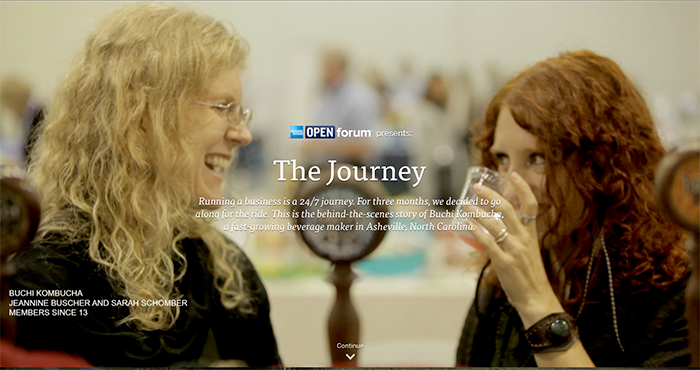Content has been king among marketing strategies for several years now, and it’s evolved rapidly during that time. We’ve seen content influence everything from social media to the way we think about thought leadership, and now a new trend is on the rise. Longform storytelling is the future of content marketing.
Deeply researched, eloquently written narratives have long been the gold standard of great journalism. So it’s no surprise that longform storytelling has made its way into the marketing world, since the lines between traditional media and branded content become blurrier all the time.

American Express demonstrated this clearly with its thoroughly reported multimedia feature on an Asheville, N.C., kombucha company. Medium is quickly becoming homebase for prolific thinkers, writers and media websites. And with The Wall Street Journal and The New York Times now running content studios, we can expect to see even more high-quality longform features coming out of the world’s top brands.
The Logic Of Longform
It’s easy to see why content marketing is headed in the longform direction. Such packages often have a longer shelf life than more timely articles, and they allow brands to explore diverse topics in depth. If you’re working on a financial brand, you can create blog posts or ebooks that delve into such dense subjects as day trading versus investing in annuities. The flexibility of the format allows you to weave your brand’s personality throughout the writing and build trust through the engaging content.
Many companies have found that longform content significantly increases their conversion rates, because their customers simply respond better to interesting, in-depth content vs. shorter, run-of-the-mill pieces.
A compelling, humorous, or otherwise evocative piece of writing initiates a different kind of customer relationship than a quick hit “X Tips to Financial Success” blog post. The latter is emotionless and easily forgotten; the former stays with readers. Longform features present great opportunities to take external audiences behind the curtain. People do business with other people, and great narratives humanize even the biggest corporations.
That’s why the American Express piece was such a hit. It was thoughtful and unexpected, and it showed another side of the company’s interests. When you connect consumers with the actual people who make your company move, the more loyalty they’ll have for your brand.
How To Tell Great Stories
You don’t have to be a powerhouse publisher to create quality longform content. The opportunities to share your brand’s narrative are limitless if you know where to look. About Us pages are a fantastic place to start, since this is often one of the first places new customers go to learn about who they will be doing business with. You can also weave your story through social media and blog content, then expand on your values in longer articles. Use the following strategies to up your narrative offerings in the new year.
1. Educate your content producers on storytelling basics.
Even if they’ve studied writing in college or grad school, it never hurts to take a refresher course and learn new strategies. There are lots of great books, courses, and blog posts that will help your team members take their storytelling games to the next level.
2. Create a storytelling culture.
One-on-one customer conversations make great narrative fodder, which is why PemCo Insurance CMO Rod Brooks starts his meetings by asking everyone to share a customer story from the previous week. This habit inspires people to pay more attention to potential content opportunities and look for ways to turn customer conversations into great anecdotes.
Keep an eye out for team members who are natural storytellers, the ones who always have a great turn of phrase or share the most unique customer details. These people are goldmines for generating interesting, engaging longform projects.
3. Implement strategies to capture customer feedback.
Testimonials provide a wealth of content talking points if you leverage them effectively. Sean D’Souza of Psycho Tactics recommends doing a Brain Audit to get inside your customers’ minds so you can tailor your marketing to them.
Copyblogger takes it a step further with probing questions about why customers bought certain products, what obstacles might have prevented them from buying, and what other uses they suggest for it. Such queries will give you rich, colorful details that are perfect for longform storytelling.
4. Formalize your process.
Once you have staff members looking for story ideas, you need a workflow for turning those tidbits into articles, blog posts, ebooks, and other materials. Establish a system for submitting and approving ideas, and have a clear breakdown of who is responsible for editing and publishing the content. BTW, DivvyHQ can help with that.
5. Be realistic and consistent.
If you’re a small startup with a limited marketing department, don’t commit to doing multi-faceted monthly features that you can’t actually produce. Create content as often as you can while still maintaining the highest quality possible. This is where customer testimonials and anecdotes will come in handy, because your team can write great blog posts off of those in between larger releases.
Is Longform Storytelling Right for Your Business?
Longform storytelling isn’t just a must-have in your branding strategy. It’s also an incredible opportunity to take your tribe behind the scenes, showing them who you and your team really are. The time and energy it takes to build compelling stories and unique content experience pays off many times over, because people buy from brands they love. And the first step towards them falling in love is letting them get to know you.